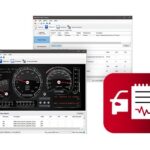Since their inception in the 1980s, On-Board Diagnostic (OBD) systems have revolutionized vehicle maintenance. Initially, these systems served merely to alert drivers to potential issues via the Malfunction Indicator Lamp (MIL), offering little insight into the problem’s specifics. However, as automotive technology advanced, the complexity and data-gathering capabilities of OBD systems expanded significantly.
The evolution of OBD systems is broadly categorized into two phases, each defined by the prevalent system type:
1) OBD-I: The Era of Proprietary Systems
The first generation of OBD systems, known as OBD-I, was characterized by its proprietary nature. Before 1990, each vehicle manufacturer developed its own unique diagnostic system. This lack of standardization meant that the diagnostic codes, communication protocols, and the type of data collected varied significantly across different makes and models.
Alt text: A visual representation of the OBD system evolution from basic alerts to standardized data collection, highlighting the transition from OBD-I’s complexity to OBD-II’s uniformity.
This fragmented approach presented considerable challenges for automotive technicians. To effectively diagnose vehicles, technicians were often required to invest in a diverse array of specialized tools and connector cables, each tailored to a specific manufacturer. Alternatively, they might opt for expensive, multi-brand scanners equipped with numerous adapter cables. The proprietary nature of OBD-I systems often directed vehicle owners to dealerships for even basic diagnostic services, limiting independent repair options.
The movement towards standardization gained momentum when the California Air Resources Board (CARB) mandated OBD capabilities for all vehicles sold in California starting in 1991. However, CARB’s initial mandate lacked specific standards, which ironically further complicated matters for both manufacturers and users. It was not until the introduction of the OBD-II standard in 1994 that a unified approach began to take shape. Consequently, all preceding proprietary systems were retroactively classified under the OBD-I designation.
2) OBD-II: The Standard for Modern Diagnostics
In 1994, the California Air Resources Board (CARB) established OBD-II as a comprehensive set of standards for On-Board Diagnostic systems across all vehicles marketed in California. This mandate became officially effective for the 1996 model year vehicles and has remained the industry standard ever since. Complementing CARB’s initiative, both the Society of Automotive Engineers (SAE) and the International Organization for Standardization (ISO) developed parallel standards defining the protocols for digital data exchange between a vehicle’s Electronic Control Units (ECUs) and diagnostic scan tools.
Alt text: Image of a standard OBD-II connector, emphasizing its uniform design for broad compatibility across vehicle makes and models in modern automotive diagnostics.
The Environmental Protection Agency (EPA) further broadened the impact of OBD-II through the Clean Air Act. By 2001, 33 states and numerous local regions had implemented mandatory vehicle emissions inspections, with OBD-II systems playing a crucial role in these assessments.
The OBD-II standards are defined by several key specifications, including:
- Standardized OBD-II Connector: Modern OBD systems utilize standardized Diagnostic Link Connectors (DLCs), specifically the Type 2 Connector. This standardization enables technicians to employ a single, universal Type 2 cable to access the digital communication interface within the OBD system through a designated port. While the exact location of this port can vary, it is commonly found beneath the dashboard on the driver’s side of the vehicle.
- Comprehensive System Monitoring: The EPA mandates that OBD systems must monitor components and systems that can impact vehicle emissions. While emission-related monitoring is the minimum requirement, many OBD-II systems extend their monitoring capabilities to include other vehicle parameters. This broader scope facilitates more efficient identification and resolution of a wider range of vehicle malfunctions, going beyond just emissions-related issues.
With the implementation of OBD-II standards, automotive technicians gained the ability to service a wider spectrum of vehicles more efficiently and with greater ease. The reliance on manufacturer-specific tools diminished significantly, streamlining the diagnostic process and empowering both professional mechanics and car owners with enhanced diagnostic capabilities through OBD scanners. Understanding “Obd Scanner Stands For” – On-Board Diagnostics scanner – is the first step in leveraging this powerful technology for vehicle maintenance and health monitoring.

